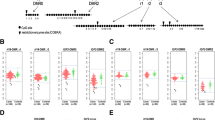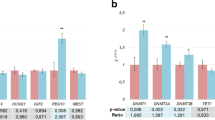Abstract
Aim
6q24-related transient neonatal diabetes mellitus (6q24-TNDM) is a rare imprinting disorder characterized by uncontrolled hyperglycemia during the first 6 months of life. The molecular etiology of 6q24-TNDM is attributable to overexpression of the paternally inherited PLAGL1 and HYMAI genes located on the 6q24 locus. One of these major defects is maternal loss of methylation (LOM) at 6q24. In addition, approximately 50% of TNDM patients that present LOM at 6q24 can also display hypomethylation at additional imprinted loci (multilocus imprinting disturbances, MLID). Interestingly, the majority of these patients carry mutations in the ZFP57 gene, a transcription factor required for the adequate maintenance of methylation during early embryonic development.
Methods
Methylation analysis of 6q24 and additional imprinted loci was carried out by MS-MLPA in a Tunisian male patient with clinical diagnosis of TNMD. For the same patient, mutation analysis of the ZFP57 gene was conducted by direct Sanger sequencing.
Results
We report a novel nonsense mutation (c.373C > T; p.R125*; ENST00000376883.1) at the ZFP57 gene causing TNDM-MLID and describe detailed phenotype/epigenotype analysis of TNMD patients carrying ZFP57 mutations.
Conclusion
We provide additional support to the role of ZFP57 as a genetic determinant cause of MLID in patients with TNMD.

Similar content being viewed by others
References
Iafusco D, Massa O, Pasquino B et al (2012) Minimal incidence of neonatal/infancy onset diabetes in Italy is 1:90,000 live births. Acta Diabetol 49:405–408
Deeb A, Habeb A, Kaplan W et al (2016) Genetic characteristics, clinical spectrum, and incidence of neonatal diabetes in the emirate of Abu Dhabi, United Arab Emirates. Am J Med Genet Part A 170A:602–609
Demirbilek H, Arya VB, Ozbek MN et al (2015) Clinical characteristics and molecular genetic analysis of 22 patients with neonatal diabetes from the South-Eastern region of Turkey: predominance of non-KATP channel mutations. Eur J Endocrinol 172:697–705
Docherty LE, Kabwama S, Lehmann A et al (2013) Clinical presentation of 6q24 transient neonatal diabetes mellitus (6q24 TNDM) and genotype-phenotype correlation in an international cohort of patients. Diabetologia 56:758–762
Temple IK, Gardner RJ, Mackay DJG et al (2000) Transient neonatal diabetes: widening the understanding of the etiopathogenesis of diabetes. Diabetes 49:1359–1366
Mackay DJG, Boonen SE, Clayton-Smith J et al (2006) A maternal hypomethylation syndrome presenting as transient neonatal diabetes mellitus. Hum Genet 120:262–269
Lemelman MB, Letourneau L, Greeley SAW (2018) Neonatal diabetes mellitus: an update on diagnosis and management. Clin Perinatol 45:41–59
Mackay DJG, Temple IK (2010) Transient neonatal diabetes mellitus type 1. Am J Med Genet C Semin Med Genet 154C:335–342
Mackay DJG, Callaway JLA, Marks SM et al (2008) Hypomethylation of multiple imprinted loci in individuals with transient neonatal diabetes is associated with mutations in ZFP57. Nat Genet 40:949–951
Boonen SE, Pörksen S, Mackay DJG et al (2008) Clinical characterisation of the multiple maternal hypomethylation syndrome in siblings. Eur J Hum Genet 16:453–461
Bak M, Boonen SE, Dahl C et al (2016) Genome-wide DNA methylation analysis of transient neonatal diabetes type1 patients with mutations in ZFP57. BMC Med Genet 14:17–29
Docherty LE, Rezwan FI, Poole RL et al (2014) Genome-wide DNA methylation analysis of patients with imprinting disorders identifies differentially methylated regions associated with novel candidate imprinted genes. J Med Genet 51:229–238
Boonen SE, Mackay DJ, Hahnemann JM et al (2013) Transient neonatal diabetes, ZFP57, and hypomethylation of multiple imprinted loci. Diabetes Care 36:505–512
Li X, Ito M, Zhou F et al (2008) A maternal zygotic effect gene, Zfp57, maintains both maternal and paternal imprints. Dev Cell 15:547–557
Begemann M, Leisten I, Soellner L et al (2012) Use of multilocus methylation-specific single nucleotide primer extension (MS-SNuPE) technology in diagnostic testing for human imprinted loci. Epigenetics 7:473–481
Quenneville S, Verde G, Corsinotti A et al (2011) In embryonic stem cells, ZFP57/KAP1 recognize a methylated hexanucleotide to affect chromatin and DNA methylation of imprinting control regions. Mol Cell 44:361–372
Liu Y, Toh H, Sasaki H et al (2012) An atomic model of Zfp57 recognition of CpG methylation within a specific DNA sequence. Genes Dev 26:2374–2379
Baglivo I, Esposito S, De Cesare L et al (2013) Genetic and epigenetic mutations affect the DNA binding capability of human ZFP57 in transient neonatal diabetes type 1. FEBS Lett 587:1474–1481
Court F, Martin-Trujillo A, Romanelli V et al (2013) Genome-wide allelic methylation analysis reveals disease-specific susceptibility to multiple methylation defects in imprinting syndromes. Hum Mutat 34:595–602
Boyraz M, Ulucan K, Taşkın N et al (2013) Transient neonatal diabetes mellitus in a turkish patient with three novel homozygous variants in the ZFP57 gene. J Clin Res Pediatr Endocrinol 5:125–128
Iyigun F, Ozcan B, Kulali F et al (2017) A newborn with transient diabetes mellitus accompanied by ketoacidosis attributable to a ZFP57 mutation. J Trop Pediatr 63:399–401
De Franco E, Flanagan SE, Houghton JA et al (2015) The effect of early, comprehensive genomic testing on clinical care in neonatal diabetes: an international cohort study. Lancet 386:957–963
Garin I, Edghill EL, Akerman I et al (2010) Recessive mutations in the INS gene result in neonatal diabetes through reduced insulin biosynthesis. Proc Natl Acad 107:3105–3110
Sansbury FH, Flanagan SE, Houghton JA et al (2012) SLC2A2 mutations can cause neonatal diabetes, suggesting GLUT2 may have a role in human insulin secretion. Diabetologia 55:2381–2385
Yorifuji T, Kurokawa K, Mamada M et al (2004) Neonatal diabetes mellitus and neonatal polycystic, dysplastic kidneys: phenotypically discordant recurrence of a mutation in the hepatocyte nuclear factor-1beta gene due to germline mosaicism. J Clin Endocrinol Metab 89:2905–2905
Bowman P, Sulen Å, Barbetti F et al (2018) Neonatal Diabetes International Collaborative Group. Effectiveness and safety of long-term treatment with sulfonylureas in patients with neonatal diabetes due to KCNJ11 mutations: an international cohort study. Lancet Diabetes Endocrinol 6:637–646
Clissold RL, Hamilton AJ, Hattersley AT (2015) HNF1B-associated renal and extra-renal disease-an expanding clinical spectrum. Nat Rev Nephrol 11:102–112
Setoodeh A, Rabbani A (2012) Transient neonatal diabetes as a presentation of Fanconi–Bickel Syndrome. Acta Med Iran 50:836–838
Author information
Authors and Affiliations
Corresponding author
Ethics declarations
Conflict of interest
The authors declare that they have no competing interest.
Ethical approval
Ethical procedures followed were in accordance with the ethical standards of the responsible committee on human experimentation (institutional and national, local ethics committee: Comitato Etico Centrale IRCCS Lazion, Sezione IFO/Fondazione Bietti, Rome, Italy) and with the Helsinki Declaration of 1975, as revised in 2008.
Informed consent
Informed consent was obtained from the patient included in the study.
Additional information
Managed by Massimo Porta.
Electronic supplementary material
Below is the link to the electronic supplementary material.
Rights and permissions
About this article
Cite this article
Touati, A., Errea-Dorronsoro, J., Nouri, S. et al. Transient neonatal diabetes mellitus and hypomethylation at additional imprinted loci: novel ZFP57 mutation and review on the literature. Acta Diabetol 56, 301–307 (2019). https://doi.org/10.1007/s00592-018-1239-3
Received:
Accepted:
Published:
Issue Date:
DOI: https://doi.org/10.1007/s00592-018-1239-3




